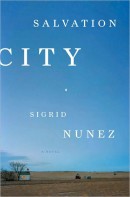 Nunez’s sixth novel joins the ever-growing shelf of Apocalyterature. Set after an influenza pandemic has swept through America, Salvation City follows a boy named Cole, whose liberal parents were KO’ed by the plague. He ends up in the titular community, a religious community where he’s raised by doctrinaire Christians. Mark Athitakis says that the dystopian backdrop isn’t really the point:
Nunez’s sixth novel joins the ever-growing shelf of Apocalyterature. Set after an influenza pandemic has swept through America, Salvation City follows a boy named Cole, whose liberal parents were KO’ed by the plague. He ends up in the titular community, a religious community where he’s raised by doctrinaire Christians. Mark Athitakis says that the dystopian backdrop isn’t really the point:
There’s enough violent imagery to suggest the horrors of living in a time when a substantial proportion of the population has been quickly killed off, but it’s a story about the boy, not the world; the book has more in common with the homey coming-of-age novels of Tony Earley than Cormac McCarthy’s The Road.
Contrasting Cole’s old and new families, Athitakis also notes that “the novel is as much a culture-versus-culture story as a boy-versus-nature tale.” Jonathan Messinger agrees, writing that “Nunez is more interested in the conflict of faith and reason than a postapocalyptic society, and pandemics and adolescence turn out to be qualified crucibles.”
In the New York Times, Abraham Verghese says, “Nunez tells a fine tale, avoiding clichés and providing powerful insights. . . . . Through Cole’s eyes, the redemption offered by religion is offset by its hypocrisy; he finds his enlightenment not from dogma but from his own painful experiences. By the end of this satisfying, provocative and very plausible novel, Cole doesn’t believe that the world is about to end.”
Athitakis thinks the ending is where Nunez trips up: “Nunez needn’t come down hard on either side, but splitting the world unnaturally into factions means the characters become a little unnatural as well. Cole ultimately comes to a decision about the world he’ll live in, but his late-stage decisiveness feel more like a necessary device to tie the bow on the story than a natural result of his novel-long questioning.”
Salvation City by Sigrid Nunez
Riverhead, 288 pp., $25.95

